Wednesday, April 28, 2010
And You Thought You Knew How to Shop...
So, thanks to Liz, you now know where to look for eco-friendly products online, but what about your everyday shopping at the mall or at a shop downtown. I want to give you some tips so even at your average boutique you can choose the right clothing to be eco-friendly and sustainable.
-One of the most important things when shopping is to look at the fabrics used and the quality and durability of the clothing itself. Cotton is one of the most environmentally harming resource when pesticides and fertilizers are used in its production. On tags look for "Organic Cotton" labels. Also look for fabrics like bamboo that are naturally sustainable materials. Many companies have started using recycled plastic bottles to produce shirts and jackets and that is clearly marked on the tags. One thing to avoid in the making of products is textile finishing. Finishes on garments like stain-resistance, moth-proofing, and anti-mildewing almost always use harmful chemicals.
-Shop for labels saying "Made in the USA." Buying local reduces shipping costs and your carbon footprint. Less shipping means fewer travel emissions and supports the local economy.
-Look for clothing that does not need dry-cleaning. The majority of dry-cleaning agents are carcinogenic, or can cause cancer. Need I say more?
While the first thing I look at when shopping is the clothing item itself...the tag should follow shortly after that. Check out this website for helpful hints: Care2
Fashion like the British
Britain's Department for Environment Food and Rural Affairs (Defra) is making great strides in transforming the fashion industry from a consumerist society into a sustainable contribution. At the start of the 2009 London fashion week Defra Minister Lord Hunt announced the Sustainable Clothing Roadmap to make fashion more sustainable and less environmentally damaging.
Lord Hunt stated that “Retailers have a big role to play in ensuring fashion is sustainable. We should all be able to walk into a shop and feel that the clothes we buy have been produced without damaging the environment or using poor labour practices, and that we will be able to reuse and recycle them when we no longer want them."
The sustainable roadmap focuses on these four areas:
- Improving environmental performance across the supply chain, including: sustainable design; fibers and fabrics; maximizing the reuse of products, recycling and managing the end of life for the products; and clothes cleaning.
- Awareness, media, education and networks for the sustainability of clothes.
- Promoting markets for sustainable clothing.
- Improving traceability along the supply chain (environmental, ethical, and trade).
Tuesday, April 27, 2010
Surfin the Green Wave

Throughout this whole blogging process (which is very new to me, by the way), I have had to do extensive research about eco-friendly living. As I am obviously no authority on the matter, I have had to rely on the expertise of others in order to find new and interesting things to tell you about.
This experience has been an eye-opening one for me. Initially Lydia and I thought that this idea for our blog was a fairly creative one. Yet after getting started, we began to realize that we were small fish in a large pond. There are dozens of both small and large blogs about eco-friendly living, dressing, and decorating, and it has been so much fun to see what else is out there.
On that note, I thought that I should share some of the great sites that I have found in the hopes that you will enjoy looking at all of them just as much as I have:
2 Modern (includes an Eco-Friendly section)
Chic Tip (includes a Green Design category)
Design Public (includes a section called Sustainable Design)
Uncommon Goods (under collections, they have Recycled Home and Recycled Jewelry sections)
Velocity Art and Design (includes an Eco-Friendly category)
Enjoy!
Sunday, April 25, 2010
Ecouterre
As Liz has mentioned earlier in her posts, for lovers of clothing and the environment ecouterre.com is the site to visit. In the editor-in-chief's words, “Ecouterre is a website devoted to the future of sustainable fashion design.” While they do not produce their own clothing or materials, the team of writers showcases and supports eco-friendly designers who focus on a garment’s environmental impact as much as the style and form of clothing.
Originally designed as the website Inhabitat.com, the founder of ecouterre launched the site to shift the image of “green” clothing from itchy t-shirts to high fashion. While hard-core environmentalists tend to turn their noses up at the importance of fashion design, the apparel industry is so large that to ignore their environmental impact would be devastating.
The websites' mission page is filled with shocking statistics about the damage of growing mass amounts of cotton and the harmful pesticides used. If you are like me, as soon as you visit the site, you wont be able to stop searching the tens of designers and hundreds of styles to view….so explore a little and this site will give you a good and green excuse to online shop :).
Friday, April 23, 2010
World Cup of Jerseys

Did you ever think about the amount of clothing professional athletes go through? Or better yet, how thousands of fans watch as men and women run around in brightly colored jerseys and uniforms? Well Nike is making a statement by outfitting World Cup soccer teams in recycled PET bottle uniforms. This will be the first time that all of the Nike teams will be wearing environmentally friendly jerseys.
Millions of plastic bottles are thrown away everyday across the globe, and Nike takes the discarded plastic bottles from landfills in Taiwan and Japan, melts them down into yarn, and then spins them into fabric. With the recycled jerseys, Nike has diverted nearly 13 million plastic bottles from the landfill. Each shirt comprises up to eight recycled plastic bottles, a move that reduces energy consumption by up to 30 percent compared with manufacturing virgin polyester.
While the everyday person may not be privileged enough to have Nike design your uniform, the company provides numerous green clothing items and we must recognize the importance in supporting mega companies that truly make a difference in the world and to the environment.
Saturday, April 17, 2010
BKLYN Design Show

Image via BKLYN Designs
In general, a lot of our blog posts have been given fairly practical advice and shown some good, everyday tips that everyone can use. But sometimes, it’s really just fun to see what’s out there that’s new, different, innovative, and just a bit crazy in the eco-design field.
Already mentioned multiple times (‘cause it’s just that awesome!), Inhabitat is the place to go for these fresh, unusual, and often avant-garde design ideas. One of their recent posts was absolutely incredible because it included a video showing new designers’ work being displayed and tried out by attendees of the BKLYN Design Show.
Watch the 5-minute video here at Inhabitat.com.
In the video, you will see designers explain and display their work. The first designer’s chair is made out of an old buoy, some aluminum, and a piece of cork. Then we are shown a chair—made by a designer calls his crafts “Fun-iture”—made completely out of reclaimed tennis balls from Columbia University’s tennis courts.
My favorite quote of the piece:
When I first started making furniture, I would lead with the form and then search for material. But when I became a sustainable designer, I looked for the material first, and the material dictates both the form and the function.
I thought that this quote was very insightful. But don't take my word for it... go to the website and see for yourself!
Wednesday, April 14, 2010
Sit on Something Sustainable

When furnishing your home, it’s important to look at what materials those couches, tables, and chairs are made out of. Here is some food for thought for those for those eco-friendly interior decorators.
The website Vivavi offers modern green furniture and furnishings. I spent a long time looking at this website, and one of my favorite parts is that next to every product they tell you “What Makes it Green.” For example, they mention features such as FSC Certified wood, non-toxic finish, no-VOC paint, and/or wind & solar powered production facility.
One company that produces eco-friendly furniture is Brave Space Design. Again, they go into incredibly technical detail when describing why each piece is eco-friendly and what went into the design.
Another idea is to look for products made of reclaimed wood like this one from Uncommon Goods. The wood is essentially taken from a building, deck, or something else and is given a second life by making it into furniture.
If you’re more daring, try out these amazing furnishings made out of—incredibly—recycled cardboard. These innovative designs made by Lazerian Studio, pictured above, are “intricate sculptural forms that are structurally stable enough to be used as furnishings.” Also, the repeated forms used throughout the designs cut down on waste during the construction.
Whatever your design aesthetic, your should definitely look into eco-friendly furniture when furnishing your place. You’ll be saving the environment, and each piece will have a unique story!
Friday, April 2, 2010
Home Improvement
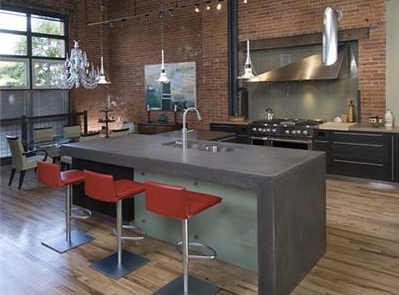
Image via concretenetwork.com
With the housing market faring so poorly these days, many families are deciding to update their living spaces rather than moving to new homes. If you decide to renovate any part of your home, make sure to consider all of your sustainable options.
Today there are more eco-friendly flooring options than ever before. If you want wood floors, remember to look for the certification mark by the Forest Stewardship Council to guarantee the wood is sustainable. Bamboo is another great option because it is a rapidly renewable resource. Natural linoleum is made from renewable raw materials such as linseed oil, pine rosin, wood flour, and jute. It is also versatile in its color and design options.
If you are replacing your countertops, it is smart to stay away from the generally popular choice of granite, which is nonrenewable and requires significant energy to extract and ship. Instead, consider strong and durable recycled composites. Though they look like stone, they can be made from recycled paper or glass. Another option is low-impact concrete, which can be poured in place and molded into any shape.
Is it your walls that need a touch-up? As I’ve said before, make sure to use low- or no-VOC paint. You can also try natural clay plaster, which has been used for thousands of years because of its strength and longevity. Conveniently, it also controls moisture, absorbs odors, and doesn’t attract dirt.
So if you are thinking of updating your home, take a moment to consider all of the sustainable options. Not only will you be making your home more beautiful, but you will also be making our world a more beautiful and sustainable place.
Wednesday, March 31, 2010
New Life for Old Fashion
 Image via Clothing
Image via ClothingSo you have those 3 tops, 2 dresses, a pair of jeans, and 6 sweaters that you just don't wear anymore...ever. Instead of throwing them away, you have several eco-friendly options for discarding your clothing.
1. Pass them on to someone in need: Miracle Hill, The Salvation Army, and Good Will are all national and international companies that either donate clothes to the homeless and under-priveleged families. What could be more rewarding than giving new life to your clothing by helping someone else?
2. Try a clothes swap with your friends. Invite a group of 8 or 10 over for snacks and drinks and tell everyone to bring clothing from their closets that they don't wear anymore (in good condition of course). Each guest receives a ticket for each piece of clothing they bring in. Each ticket brought in means you get to take home that many pieces of clothing too. Use this site to give you more fun ideas for the party. It's a great way to have a good time with your friends and lets other people enjoy the clothes you are through with.
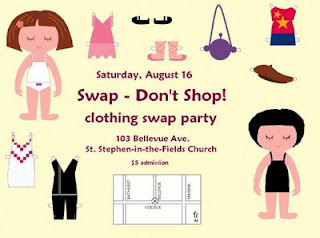 Image via Swap
Image via Swap3. Transform your clothes into something other than clothing. With an old sweater you can cover a pillow to throw on your couch. Old undershirts can be used as dust rags and cleaning cloths, and if you're handy with a sewing machine, make a quilt out of your favorite t-shirts.
So before you throw that trash bag of clothes away, think of this blog and help save the environment.
Monday, March 29, 2010
Maybe Furman's Color Should be Green Instead of Purple...

After fourteen months of being shown off to over 25,000 visitors, the building has been transformed to the new home of the David E. Shi Center for Sustainability at Furman. The purpose of the center is to coordinate all of Furman’s academic, co-curricular, research and community outreach activities related to sustainability. According to its website, the Shi Center’s core mission is to coordinate the university’s efforts to enrich the present and enhance the future for Furman and the upstate of South Carolina, and to provide a rich array of opportunities for students and the community to engage in sustainability through coursework, applied research, leadership experiences, and community service.
Saturday, March 27, 2010
Rent, Borrow, and Steal the Runway
Formal wear and designer bags are just a couple of items purchased tha never get the wear and tear for the money spent on them. Hundreds to thousdands of dollars are spent on items only worn once or twice for special occasions. These decisions just don't make sense if youare trying to be financially and environmentally sustainable. Insert Rent the Runway and Bag, Borrow and Steal.
Rent the Runway is a website that gives users access to high fashion designs for a low price. You simply sign up with your email address and can browse hundreds of designer dresses. Pick out your favorite dress and you can rent the dress for a night or weekend ranging in prices depending on value of the dress. RTR then mails you the dress in two sizes to make sure you have a fit and it is yours to enjoy. Then send back the dress in the pre-paid package they provide. They even take care of the dry-cleaning! This means that each dress can get used as many times as it will last so there's no waste of money or clothing.
Bag, Borrow, or Steal is a similar concept except you can rent designer bags and jewelry. as they put it "Why should celebrities, fashion editors, and socialites be the only ones allowed to borrow fashion accessories?" The difference here is you can pay to keep an item for a longer period of time and if you fall in love with a piece, you can "steal" it and pay a portion of the price to own an item for yourself.
While these sites might just seem like online shopping, they are reducing the amount of dresses being made and sold and limiting wasteful spending and therefore reducing our carbon footprint.
Wednesday, March 24, 2010
The Green Room

Lydia and I go to Furman University, where there’s something really cool going on this year on the Kappa Delta sorority hall. The Green Room Energy and Environmental Initiative Showcase Room (or just the Green Room for short) is a dorm room that has been outfitted with numerous environmentally friendly details. According to the website, “The intent of the project is to showcase, and in the process foster, eco-friendly lifestyle choices and product selection among students in an effort to help the university reduce its carbon footprint.”
Here’s what Paige, the current resident of the Green Room, had to say about the project:
“The Green Room is the first of its kind of Furman, meant to showcase how students can make simple lifestyle changes and product choices to significantly reduce their carbon footprint and impact on the environment. It does not look any different when you walk in, but it is fitted with eco-friendly products and sustainability materials. Living in the Green Room has shown me that being sustainable can be as easy as changing a few purchases that you already have to buy, to ones that are better for the environment and help to conserve energy. It is an important showcase to help foster interest in sustainability on Furman's campus.”
Though it looks pretty standard, this “living laboratory” took a lot of collaborative efforts to get off the ground. It was brought about by Furman student Andrea Triplitt, Furman University’s Environmental Action Group (EAG), the University’s Office of Housing and Residence Life, and the Center for Sustainability. It was funded through a National Wildlife Federation Campus Ecology Grant as well as contributions from the Office of Housing and Facilities Services.
I think that this is a GREAT example of how little choices that we all make in our everyday lives can eventually make a sizable difference to the environment. I hope Furman keeps it up, and that the initiative spreads further on campus!
Tuesday, March 23, 2010
Running into a Healthy Environment
 Image via Brooks Running
Image via Brooks RunningIf I mentioned recycled shoes…you would most likely immediately think about Toms shoes. The minimalist “Keds-like” shoes that are centered on One for One, donating a pair of shoes to a child in need every time a pair is purchased. But what about those times when you need a little more substance in a shoe? Walking, running, working out? Sacrificing quality could mean sacrificing health in these instances, so eco-friendly running shoes tend to be a final thought when choosing a pair of tennis shoes.
Brooks running shoes have been known throughout the running world to be supportive and have a great fit. Building off the momentum gained by our 2006 Runner’s World International “Best Innovation” Award for our environmentally sustainable development projects, Brooks has introduced the first-ever biodegradable running shoe midsole: BioMoGo. Most of the performance running shoes are produced using BioMoGo and even the shoe boxes are printed using water-based inks. From a sprinting flat, to a trail-walker, Brooks gives you choices to help find the perfect shoe for you. And now that is much more easier knowing that the company is making your running that much healthier for the environment too.
If, in fact, you cannot find that perfect pair of running shoes that is eco-friendly, Nike has an amazing program that recycles every part of the shoe, from the fabric to the rubber, to create running tracks and basketball and tennis courts.
Monday, March 15, 2010
Upcycling
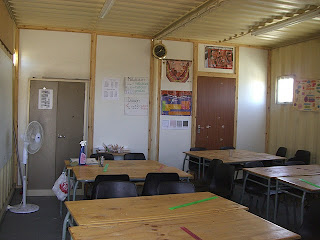
Ever heard of upcycling? I only recently came upon this term when exploring my favorite eco-fashion site, Ecouterre. The fashions that they feature very often highlight designers who “upcycle” non-clothing items and make them into stylish apparel. The online dictionary of sustainable management defines upcycling as “the process of converting an industrial nutrient (material) into something of similar or greater value, in its second life.”
Upcycling is easier than it sounds. You can start very simply: instead of throwing away or recycling glass bottles, use them as vases for flower arrangements. (Or for a more chic version, check out these designs made from old wine bottles.) Here in the south, it’s also common to use old glass Mason jars as drinking glasses.
If you’re a looking for an easy do-it-yourself upcycling project, try making a bowl out of an old vinyl record. The end result can be used as a chip bowl or fruit bowl, for holding a potted plant or even as wall art.
If you enjoy entertaining, and/or really like wine, here’s a way to use your old corks and make a unique serving tray.
This website gives you great, step-by-step instructions of how to turn things like coffee cans and umbrellas into lighting fixtures for your home.
Here’s one final upcycling idea that, though it’s not something you could use for your own home, is one of the best concepts that I have actually seen in practice. When I went to Africa last spring on a study abroad program, we visited an after-school program that converted donated cargo shipping containers into classrooms (seen at top of post). Philanthropic upcycling? That’s what I call a sustainable idea.
Sunday, March 14, 2010
Patagonia's not only in Chile

So what happens when you need quality, high-performance gear and don't want to put your green efforts aside? If you like to hike, or mountain climb, or just walk to your car when it's pouring down rain, Patagonia has you covered.
Patagonia is one of the world's leading designers and producers of outdoor gear and clothing and has been committed to great quality and environmental efforts since the seventies.
Patagonia is a member of the Conservation Alliance which supports 1% for the planet, which encourages businesses to donate at least 1% of their annual net revenues to environmental organizations worldwide. On top of that, Patagonia provides wildlife grants and is even planning to create a national park.
So clearly they're doing some great work for the environment, but what makes their clothing so unique?
Time and effort are put into their designs that make then not only look good, but last forever. Some would say they look better with age. Their capilene garments are the first of their kind to draw sweat away from the body while maintaining warmth or coolness depending on the level made and come in a variety of bright and neutral colors. These garments are recycled and recyclable through the Common Threads garment recycling program.
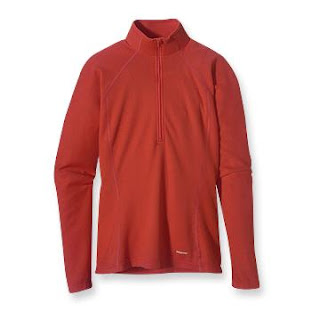
Wednesday, March 3, 2010
From Wall to Wall

Today, I’m focusing on how to liven up your walls. So far I have given you some pretty sensible advice on how to decorate your home in a more eco-friendly and economical way. To mix it up a bit, I’ve decided to make this post part practical, part whimsical.
Firstly, here’s an article on the Inhabitat blog about the elements of environmentally-friendly wallpaper. They highlight Mod Green Pod wallpaper, a line that is very bright, bold, and colorful—which I love!
Here’s a great website for the everyday decorator. Velocity offers not only eco-friendly wallpaper, but also many other types of eco-friendly wall décor, including flat prints, stretched canvases, wall decals, wall hangings, and wall panels.
For those of you who are a bit more adventurous, check out this crazy idea. Think you are living "green"? Well, the architecture and design group Nendo Studio in Japan made a house that is literally green. The Moss House located in Tokyo features moss on the interior walls shaped into a pattern that looks like a modern wallpaper. The pictures of the home are amazing.
Want art that is also functional? Take a look at Mark Kinsley’s amazing graphic wall shelving. Half wall mural, half shelving unit, this guy’s invention blows me away. Form plus function… what’s more green than doing double-duty?
Tuesday, March 2, 2010
Eco-tees
 Image via Good-Tee
Image via Good-TeeOn college campuses, t-shirts tend to make up the majority of students’ wardrobes. After a late night of studying or avoiding studying, t-shirts and jeans are the easiest choices to throw on for class. With campus organizations and Greek-life creating a new t-shirt design for every event imaginable, there are no shortages of these cotton comforts. Wouldn’t it be nice if there were a way to stop wasting old t-shirts and to have options to buy organic and recycled cotton t-shirts?
Well Graphic Cow has made our decision to go green that much easier. While making designing online and shipping around the country easy, they also provide t-shirt options from Anvil, a leading apparel brand, who was recently ranked the 6th largest organic program in the world by the Organic Exchange. While they use everything from organic cotton to recycled PET bottles, through graphic cow you have the choice of 100% organic cotton t-shirts and recycled cotton shirts as well.
Graphic cow offers t-shirts from American Apparel, which is not strictly advertised as a green company, a little background on the brand can help your mind rest at ease when purchasing these well-made and unusually soft shirts. American Apparel recycles old t-shirts to make yarn for new ones, uses non-toxic dyes, prints catalogues on 100% post consumer recycled paper, and even uses energy efficient lighting in their factories.
So when that fraternity formal or Relay for Life t-shirt needs to be made, consider the companies that can help you create a shirt that will help the environment.
Sunday, February 28, 2010
Paint it Green

One of the best ways to make something old look new again is a fresh coat of paint. Yet according to the EPA, the air indoors can be many times more polluted than the outside air, and paint can be one of the biggest offenders of indoor air pollution.
Volatile organic compounds, or VOCs, are the greatest offenders. They are potentially carcinogenic carbon-based chemicals that are extremely harmful in the home. This article outlines the potential hazards of paint. It also describes different types of environmentally-friendly paint (including low VOC paints, natural interior paints, and exterior paints), tells how to remove paint, and gives great additional tips.
Many companies have caught on and have released lines of low- or zero-VOC paints. Yet consumers must be careful about the assertions of these companies. According to this post on environmental blog Inhabitat, “there is no third party verification of the claims” of Sherwin-Williams that the whole company has become green. They go so far as to say “these types of claims [would be classified] as greenwashing."
The safest option for both your health and the environment is natural paint. While in the past they have been criticized as lacking quality, today the quality is much improved and natural paint is a great option. If you want to explore the various types of natural paints, this website provides a list of multiple natural paints and finishes.
Happy painting!
Wednesday, February 24, 2010
Don't sacrifice style to make an Environmental Statement
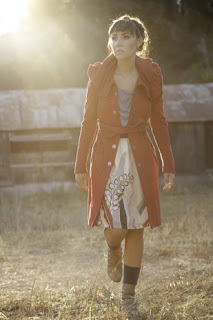 Image via Juleselin
Image via JuleselinAs commonly known, the three basic human needs in life are food, clothing, and shelter. While Liz is focusing on eco-friendly buildings and design, I would like to explore the fashion realm. Clothing and fashion can be a reflection of personal style and I would love to help reflect an environmentally conscious lifestyle with that clothing. Articles should reflect how you truly feel about your environment and world.
From hemp clothing to bottle cap belts clothing design and style has been known to suffer in order to be safe for our environment. Today this couldn’t be farther from the truth. We now have the opportunity to support environmentally friendly clothing companies without sacrificing style or comfort.
Take for example Julia Elin Burnbaum who designs for the Juleselin Company. She uses organic cotton, bamboo, and recycled fabrications to create updated styles of jackets and coats that are made to be flattering. She even uses recycled paper for packaging and shipping her products.
As Liz mentioned, designer boutiques and stylists are not the only place to look for green products. You can be your own designer by using some of the mentioned websites and stores to up-date your wardrobe and create new looks for those older styles. In this blog I hope to make accessible green designers and companies while also providing new ideas for used but re-usable fabrics and clothing.
Monday, February 22, 2010
Getting Thrifty

But there is an alternative option to new, often over-priced merchandise: try recycled goods instead. Visit your local
Salvation Army or Goodwill to find great furniture or other home decorations for a steal.
While the practice of exchanging objects at consignment stores, thrift markets, and antique shops is well established, the advent of the Internet has made this practice even more widespread. Here are some sites that help you shop on a shoestring budget while being environmentally conscious:
If you are a college student, there are often posting boards for buying and selling goods available for students. Lydia and I attend Furman University, where there is an online Classifieds forum to which all students, faculty, and staff have access. Personally, I have bought and sold many items on Furman Classifieds.
So the next time you really need an item for your home (or if you just get that shopping itch), visit one of the stores or sites listed above. You might just be surprised by what you are able to find!



